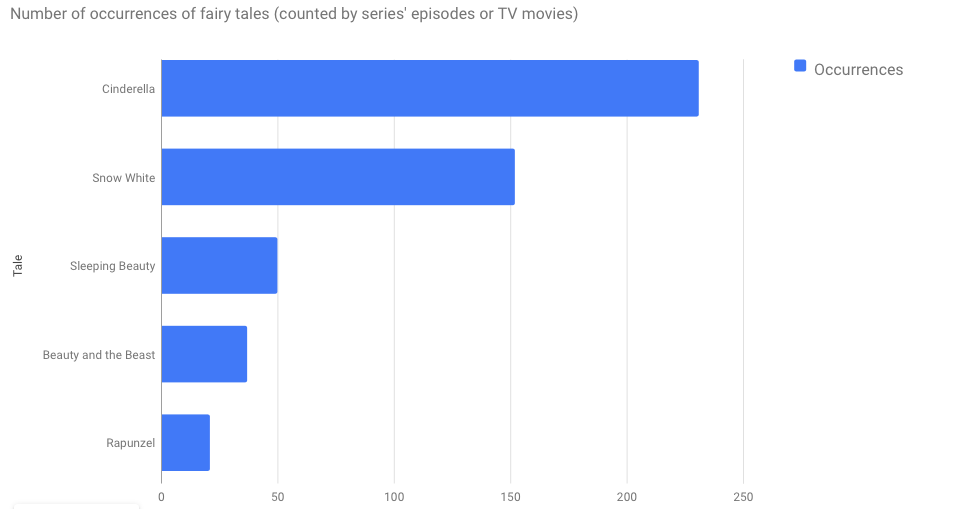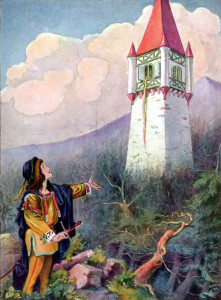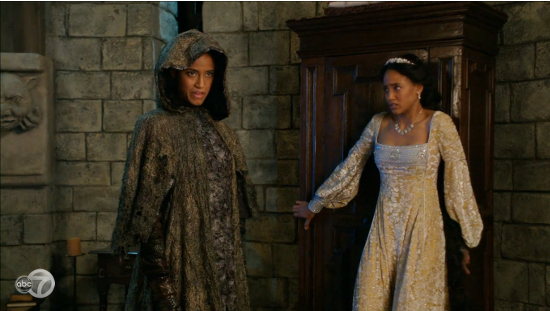This is the second in our guest post series for the summer from Dr. Rudy’s 394R class, this time written by Heidi Grether. We hope you enjoy!
We’re all familiar with the story of Rapunzel, right? A girl, a tower, and a whole heck of a lot of hair. But the shocking part of this tale isn’t necessarily the fact that she is named after lettuce or miraculously avoids headaches, but that it is so vastly underrepresented in television. Compared to Beauty and the Beast, Cinderella, Snow White, and Sleeping Beauty, it comes in dead last in terms of number and frequency of television episode occurrences over the last 70 years or so as shown below:


This caught my eye. As an avid Rapunzel fan, I was curious as to why Rapunzel showed up so infrequently. And then I wondered: does it even have any contemporary issues and parallels to today’s culture worth exploring? My answer: oh, most definitely
There are a few film versions of Rapunzel that my college-age peers are probably familiar with. The first of which is Mattel’s Barbie as Rapunzel (2002), then Disney’s Tangled (2010), and finally Disney’s Into the Woods (2014). These adaptations all contain many similarities including a prevalent emotion: fear.
Let’s focus in on the fear fostered by Mother Gothel in Tangled and the fear created by Rapunzel herself in the Once Upon a Time (OUAT) television episode titled “The Tower.”
In Disney’s Tangled, Mother Gothel sings a song delineating all the dangers of the outside world. Her pleas for Rapunzel to stay starts with external threats: “ruffians, thugs, poison ivy, quicksand, cannibals and snakes, the plague!” Are these real dangers in the world outside of Rapunzel’s tower? Yes. Yes they are. However, Mother Gothel moves from these external factors to attacking Rapunzel directly. In the last verse of the song, she sings:
Mother knows best
Take it from your mumsy
On your own, you won’t survive
Sloppy, under-dressed
Immature, clumsy – please!
They’ll eat you up alive
Gullible, naive
Positively grubby
Ditzy and a bit, well, hmm…vague
Plus, I believe
Gettin’ kinda chubby
I’m just saying cause I love you
https://youtu.be/fi8kYcl2Y38
In this verse, Mother Gothel frames her personal attack on Rapunzel with devotion, but Mother Gothel then uses comments such as “gullible,” “grubby,” and “chubby” to keep Rapunzel bound by her own insecurities and captive to the tower.
Can we just talk about emotional abuse for a second? David Royse writes that “…emotional abuse generally refers to a sustained or repeated pattern of behavior that, more than making the child unhappy, has the potential for effecting the child’s self-esteem, development, view of the world, and sense of belonging.” (Emotional Abuse of Children: Essential Information, pg 8). It would seem to me that locking up a child in a tower with no human interaction for eighteen years and using their weaknesses as a tool to keep them there would have an impact on that child’s self-esteem and view of the world.
Clearly, Mother Gothel’s façade of trying to protect Rapunzel is undermined by her emotional abuse–a main crux of the plot. Sure, part of the conflict comes from Rapunzel trying to find a way to see the floating lights, but the ultimate reward comes when Rapunzel discovers her identity as a princess and stands up to Mother Gothel’s patronization. The movie’s happy ending of fulfilled dreams and reunited families is only possible after Rapunzel overcomes the fear and insecurity insinuated by Mother Gothel . You go, Rapunzel.
The fear in OUAT, however, differs from the fear in the film because, surprise! There’s not a Mother Gothel who kidnaps Rapunzel. Rather, Rapunzel is kept in the tower by her own fear—personified by a woman in a dark cloak who resembles Rapunzel herself.
Rapunzel explains that she was chased into the tower by a “witch” after she ate night root as an attempted cure for the nightmares associated with her brother’s death. In this episode, Prince David tells Rapunzel: “She’s your fear! Only you can defeat her! You have to face it, Rapunzel you must!” and “Your fear was that you could never be a leader like your parents, like your brother. Own it and you can do this.”
Until this point, Rapunzel has crippled herself with fear, seeing as there is no indication that her parents or brother ever did or said anything to make Rapunzel believe that she could never be a leader. Thus, her inability to face her self-created fear has kept her trapped, isolated, and terrified for so long.
Does this remind you of anything? Certainly it mirrors something that so many of us struggle with in our day-to-day life: facing fears that seem too daunting to even acknowledge. This could be the fear of being rejected from a friend group or a job, the fear of heartbreak that comes with the end of a relationship, the fear of becoming a parent, or the fear associated with any number of things. But on a more serious note, could Rapunzel’s isolation and fear be associated with a more pressing contemporary issue?
Of course, scholars have taken note that Rapunzel being locked in (and eventually escaping) a tower can represent coming of age in the context of chastity. And this makes sense in the original tale when the witch discovers that Rapunzel’s clothes have become too tight around her stomach (AKA, there’s a bun in the oven, people. Or two buns if we’re following the story where she gives birth to twins.) However, in both the film and television adaptation explored here, the story doesn’t end in a baby. In fact, in the OUAT episode, there’s not even a romantic interest for Rapunzel, suggesting that the symbolism of the tower is fluid and can represent much more than a guarded woman.
 In the case of the OUAT episode, the tower can be interpreted as depression or anxiety which keeps people trapped and isolated from those that love and care for them most. This television episode is resolved only after Rapunzel defeats her fear and escapes the tower, confiding in Prince David the true reason for her brother’s death. Once she owns the fears that have kept her captive, she is reunited with her parents and is no longer isolated from those that love her. Similarly, only when people are able to open up to their emotions are they able to confront mental health concerns in a structured and supported way.
In the case of the OUAT episode, the tower can be interpreted as depression or anxiety which keeps people trapped and isolated from those that love and care for them most. This television episode is resolved only after Rapunzel defeats her fear and escapes the tower, confiding in Prince David the true reason for her brother’s death. Once she owns the fears that have kept her captive, she is reunited with her parents and is no longer isolated from those that love her. Similarly, only when people are able to open up to their emotions are they able to confront mental health concerns in a structured and supported way.
Each character and tale mentioned at the beginning of this post deal with difficult situations that are all too real when adapted for today’s society. Cinderella faces abusive family members and dreams that seem out of reach. Belle struggles with being different from those around her. Snow White must find refuge from those seeking to hurt her. Sleeping Beauty seemingly hovers on the cusp of death. Just as each of these stories have a clear relationship to issues such as family dynamics, illness, or prejudice, the story of Rapunzel applies to modern concerns of mental health and isolation.
Despite this, the story of Rapunzel persists in avoiding the limelight, especially when compared to these other tales. Why is it that Disney did not make a film starring Rapunzel until 40 years after Disney’s Golden Age of Princesses? Why is it that Rapunzel is only featured in one episode of OUAT whereas other characters have a more constant presence? While these questions remain unanswered, it seems to me that we could benefit from a further exploration of Rapunzel’s character by creating multi-faceted adaptations reflecting the more psychological issues of our day.

Rapunzel as a tale of vampirism and pedophilia. The wife’s longed wish child coincides with a trivial wish for “forbidden salad”; this is incongruent. What it really means is that she gets pregnant by something she eats, which is also a common theme in fairy tales and mythology. This something, the fruit of her womb, the GMO child, has then to be offered to the powerful witch which, as a go-between, owns her and visits her (in all likelihood accompanied) at will climbing up “golden” locks that grow and grow; the prince happens to be one of those visitors, representative of power, established society, and accepted facts. And as such he gets tricked by the witch into surrendering his power. Which he does. He goes blind (experiences darkness), while Rapunzel loses her “golden” locks (now property of the witch). She gives birth to a new couple, prince “finds” her (force to publicly accept the blackmail), recovers his sight and status but nothing happens to the witch. Meaning she is in control of the new revalued “princely” couple, who now serves her at a higher level, mirroring the original husband and wife. This is bondage at a higher level, and there is something instinctually dark about this tale. It is not about “passions”or “wishes”, but about the inner workings of power.